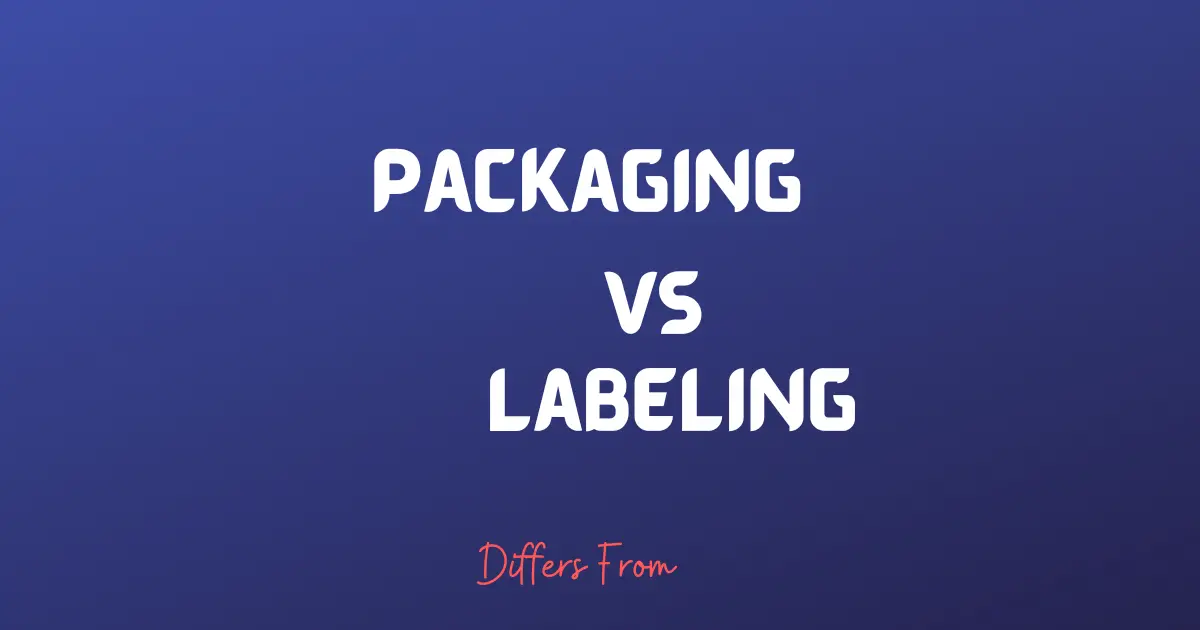Packaging and labeling are two crucial aspects of product development and marketing. They serve different purposes and play unique roles in the marketing and branding of products. However, many people need clarification on packaging with labeling or use the terms interchangeably despite their importance. This article will explore the difference between packaging and labeling and help you understand their purposes and importance.
Packaging and labeling are two essential components of product development and marketing. They play a significant role in product protection, preservation, and marketing. Packaging refers to the materials used to wrap and protect a product, while labeling is the information displayed on the packaging that provides consumers with important information about the product.
Packaging aims to protect and preserve a product, making it easier for consumers to transport, store, and use. On the other hand, labeling aims to identify the product and provide consumers with important information such as ingredients, nutritional information, and usage instructions.
Understanding the difference between packaging and labeling is crucial to ensure that products are developed and marketed correctly. This article will discuss the critical differences between packaging and labeling, including their physical characteristics, functionality, and role in marketing and branding.
Packaging
Packaging refers to the materials used to wrap and protect a product. It is the first defense against the external environment, protecting the product from damage, contamination, and spoilage. There are three types of packaging: the primary packaging, secondary packaging, and tertiary packaging.
What are functions of Packaging in Marketing?
Protection
Packaging protects the product from damage during storage, transportation, and use. This helps to maintain product quality and safety, and to prevent waste.
Convenience
Packaging can be designed for ease of use and convenience, making it easier for customers to open, use, and store the product.
Branding
Product Packaging plays a key role in the branding of products. The design and graphics used on packaging can help to create a consistent and recognizable brand image.
Promotion
Packaging can be used to promote a product and increase sales. For example, packaging can be used to highlight special promotions, discounts, and other offers.
Differentiation
Packaging can be used to differentiate a product from its competitors and make it stand out in the market. For example, unique product packaging can help a product to stand out on store shelves and attract customer attention. Unique product design is also help to build a brand identity among the consumer’s mind.
The importance of packaging cannot be overstated. It protects the product from damage, contamination, and spoilage, making it easier for consumers to transport, store, and use. Additionally, packaging design can play a significant role in branding and marketing, helping to build a brand and attract new customers. Packaging must also comply with various regulations, such as food safety and environmental regulations.
Labeling
Labeling is the process of attaching information, graphics, and branding to a product. Labeling provides customers with information about the product, including its ingredients, usage instructions, and any relevant warnings.
The functions of labeling in marketing include:
Identification
Labeling helps customers identify a product and distinguish it from other products in the market.
Communication
Labeling provides customers with information about the product and its features, benefits, and uses. This helps customers make informed purchasing decisions and encourages them to try new products.
Branding
Labeling plays a key role in the branding of products. The design and graphics used on labeling can help to create a consistent and recognizable brand image.
Regulation
Labeling must comply with various regulations, such as food labeling regulations and safety warnings. Labeling helps to ensure that products are safe for consumers and meet legal requirements.
Promotion
Labeling can be used to promote a product and increase sales. For example, Product labeling can be used to highlight special promotions, discounts, and other offers.
Importance of product labeling in marketing
The importance of labeling cannot be overstated. It provides consumers with important information about the product, helping them make informed purchasing decisions. Additionally, labeling helps to ensure that products comply with regulations, such as food safety regulations and environmental regulations. Labeling also plays a significant role in consumer protection, ensuring that consumers are not exposed to harmful products.
What is the difference between Packaging and Labeling?
| Feature | Packaging | Labeling |
|---|---|---|
| Definition | The materials used to wrap and protect a product. | The information displayed on the packaging that provides consumers with important information about the product. |
| Purpose | To protect and preserve a product and make it easier for consumers to transport, store, and use. | To identify the product and provide consumers with important information such as ingredients, nutritional information, and usage instructions. |
| Types | Primary packaging, secondary packaging, tertiary packaging. | Product labeling, shipping labeling, regulatory labeling. |
| Importance | Protects the product from damage, contamination, and spoilage. Plays a role in branding and marketing and must comply with regulations. | Provides consumers with important information and helps to ensure compliance with regulations. Plays a role in consumer protection. |
| Physical Characteristics | Typically, larger and can come in various shapes. Made from durable materials such as plastic or cardboard. | Smaller and typically rectangular. Made from paper or other flexible materials. |
| Functionality | Protection and preservation of the product. | Identification of the product and communication of information. |
| Role in Marketing & Branding | Plays a significant role in branding and marketing, helping to build a brand and attract new customers. | Provides consumers with important information, but does not play as significant a role in branding and marketing. |
Packaging and Labeling are two essential aspects of product presentation, but they serve different purposes and have distinct physical and functional characteristics. Understanding the differences between packaging and Labeling can help businesses make informed decisions about how to present their products to consumers best.
Packaging VS Labeling: Key Differences
A. Physical Characteristics
Size and Shape
Packaging is typically more significant than Labeling and can come in various shapes to accommodate the product. On the other hand, Labeling is more negligible in size and typically rectangular.
Material and Design
Packaging is made from durable materials such as plastic or cardboard to protect the product and make it easier to transport, store, and use. The packaging design focuses on the product’s protection and preservation, with a focus on functionality. On the other hand, Labeling is typically made from paper or other flexible materials, and the design is focused on providing clear and legible information for the consumer.
B. Functionality
Protection and Preservation of the Product
The primary purpose of packaging is to protect and preserve the product. Packaging helps prevent damage, contamination, and spoilage, ensuring that the product arrives in good condition. Packaging also plays a role in branding and marketing and must comply with regulations.
Communication of Information
Labeling is an essential source of information for consumers. It provides consumers important information such as ingredients, nutritional information, and usage instructions. Labeling also helps to ensure compliance with regulations and protects consumers by providing them with accurate and essential information.
Compliance with Regulations
Both packaging and Labeling must comply with regulations. Packaging must meet requirements for protection, and preservation and Labeling must meet requirements for information provision. Regulations can vary by industry and product, but businesses must ensure that they comply with all relevant regulations to avoid legal or financial consequences.
C. Role in the Marketing and Branding of Products
Packaging as a Marketing Tool
Packaging plays a significant role in branding and marketing, helping to build a brand and attract new customers. Adequate packaging can create an emotional connection with consumers, helping to increase brand loyalty and customer satisfaction.
Labeling as a Source of Information
While Labeling does not play as significant a role in branding and marketing as packaging, it is an essential source of information for consumers. Labeling gives consumers the information they need to make informed decisions about a product, including ingredients, nutritional information, and usage instructions. Accurate and informative Labeling is essential for consumer protection and can also build brand trust.
What are the different types of packaging?
Primary Packaging
This is the first layer of packaging that comes in direct contact with the product. Examples of primary packaging include blister packs, clamshells, and bags. The primary purpose of primary packaging is to protect the product and make it easier to handle and use.
Secondary Packaging
This is the next layer of packaging that provides additional protection for the product. Examples of secondary packaging include boxes, cartons, and multi-pack containers. The purpose of secondary packaging is to provide additional product protection and make it easier to transport and store.
Tertiary Packaging
This is the final layer of packaging used for bulk handling and storage. Examples of tertiary packaging include pallets and crates. The tertiary packaging aims to protect the product during transportation and storage and make it easier to handle and manage in large quantities.
What are the different types of Labeling?
Brand Label
This label promotes and differentiates a product from its competitors. An example of a brand label would be the logo and name of a soft drink company on its product. This label helps consumers recognize and remember the product and reinforces the brand identity and brand awareness.
Descriptive Label
This label provides information about the product, including its usage instructions and any relevant warnings. For example, a shampoo bottle might include a descriptive label that lists the ingredients and explains how to use the product. This label helps educate consumers and ensure that they use the product safely and effectively.
Grade Label
This type of label specifies the quality and features of the product. For example, a grade label on a bag of coffee beans might indicate the roast level (e.g., light, medium, or dark) or the origin of the beans (e.g., Colombia, Ethiopia, or Kenya). This label helps consumers understand the product’s quality and characteristics and make informed purchasing decisions.
Each label serves a different purpose and provides essential information to consumers. Businesses must carefully consider the type of Labeling that is best for their products and ensure that their Labeling is accurate, transparent, and compliant with relevant regulations and guidelines.
What is the difference between packaging and Labeling in the product mix?
Packaging and Labeling play essential roles in a product mix, but they serve different purposes and functions.
Packaging is the material used to contain and protect a product. It has physical characteristics, such as size and shape, that can influence the perceived value of a product and impact consumer behavior. Packaging also serves to preserve and protect products during storage and transportation.
On the other hand, Labeling is the information and graphics attached to a product. Labeling includes brand, informational, promotional, and regulatory labels. Labeling provides information about the product, including its ingredients, usage instructions, and relevant warnings. Labeling also serves as a source of information and as a marketing tool.
In terms of the product mix, packaging, and Labeling can influence consumer perception of a product and play a role in the overall branding and marketing strategy. For example, high-end packaging can communicate premium quality and increase the perceived value of a product, while adequate Labeling can educate consumers and encourage them to make a purchase. Businesses must carefully consider their products’ packaging and labeling options and ensure that they are aligned with their overall product mix and marketing goals.

